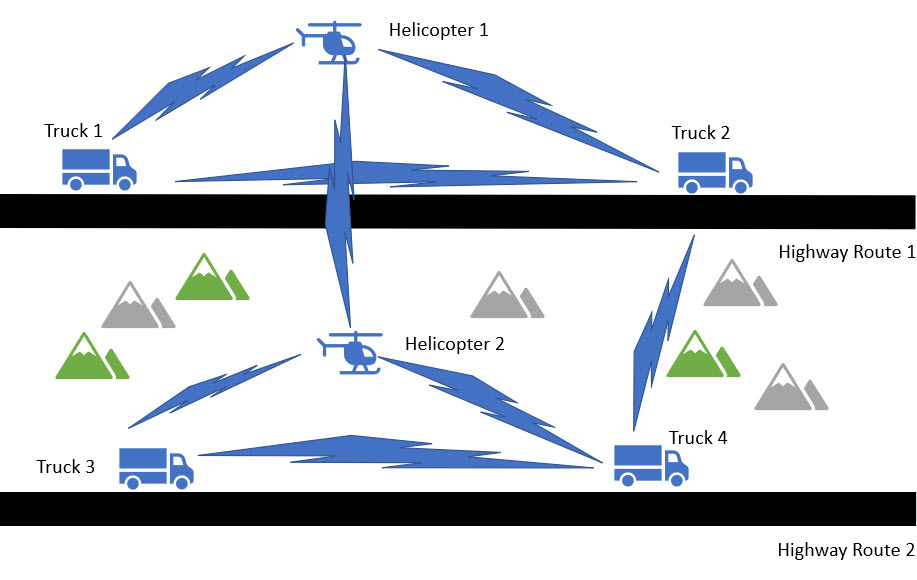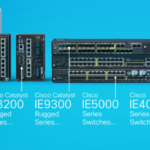Cisco Radio Aware Routing addresses several of the challenges faced when merging IP routing and radio communications in mobile networks, especially those exhibiting ad hoc (MANET) behavior. This technology has applications in the defense industry as well as state and local government for search and rescue, law enforcement, and disaster assessment.
Looking at the Real-World Problem Description – Mesh Topology
The above network is a voice, video, and data network between moving vehicles that consists of both ground and air vehicles. This mobile network is a peer-to-peer mesh that changes as topographical obstructions are encountered and is called “mobile ad hoc network” or MANET for short.
In the scenario shown above, all 4 trucks have a reliable, consistent connection with the helicopters flying over the same road. The two helicopters always have line of sight and will always have a connection between each other. The trucks may even be able to connect to the other helicopter or a truck on the opposite road when conditions are favorable. Here we see that the path between trucks 1 and 3 are completely blocked. The path between Truck 2 and 4 is about to be blocked.
Our existing routing protocols such as OSPFv3 and EIGRP need to adjust their path metrics very quickly to maintain a cohesive operational network. The routing protocol also needs a way to get information from the radios, requiring a radio to router protocol that is delivered by Cisco Radio Aware Routing in the form of two open protocols, which we will discuss here.
Cisco Radio Aware Routing provides capabilities that facilitate:
Optimal route selection based on cross-layer feedback from cooperating radios
Faster convergence when nodes join and leave the network
Flow-controlled communications between the radio and its partner router
Efficient integration of point-to-point, directional radio topologies with multihop routing
Neighbor Up / Down Status
Here is a schematic view of a piece of the network:
What Are Underlying Technical Problems that Need to be Solved?
Fluctuations in radio link quality affect throughput and need to be factored into route cost calculation.
The self-forming, self-healing nature of a mobile ad hoc network requires immediate recognition of topology changes to help ensure fast convergence.
Radios need to control the rate at which routers send information to minimize the need for queuing within the radio.
Directional radios form point-to-point or point-to-multipoint networks with neighbors, which increases the size of the router’s database and reduces routing efficiency.
What Are the Benefits of Radio Aware Routing?
Enables network-based applications and information to be delivered reliably and quickly over directional radio links.
Provides faster convergence and optimal route selection so that delay-sensitive traffic, such as voice and video, is not disrupted.
Reduces impact on radio equipment by minimizing the need for internal queuing/buffering; also provides consistent quality of service for networks with multiple radios.
How Radio Aware Routing Works – Currently Two MANET Choices
Today, radios have 2 possible RAR protocols which are both supported in select Cisco routers:
RFC-5578 – PPP over Ethernet (PPPoE) Extensions for Credit Flow and Link Metrics
RFC-8175 – Dynamic Link Exchange Protocol (DLEP)
The actual choice of protocols is largely dependent on the radio vendor and the intended applications and optimization of their devices.
RFC 5578 and RFC 8175 provide an effective, cross-layer mechanism for communicating radio network status to IP routers – RFC 5578 primarily for Time Division Multiple Access (TDMA) style radios and RFC 8175 is primarily for multiaccess shared media radios that is very similar to WiFi.
(1) RFC 5578 – PPP over Ethernet (PPPoE) Extensions for Credit Flow and Link Metrics
This solution, based on Internet Engineering Task Force (IETF) Request for Comments (RFC) 5578, employs PPP over Ethernet (PPPoE) sessions to facilitate intranodal communications between a router and a compliant device, such as a mobile radio or satellite modem. A PPPoE session is established between router and radio on behalf of every other router/radio neighbor. Once these PPPoE sessions are established, a PPP session is established end to end. This protocol is particularly suited for TDMA style radios.
Cisco Radio Aware Routing (RAR) using RFC 5578 is specifically targeted at routing over directional radio networks that are built with point-to-point links.
From the abstract of the RFC Document:
“This document extends the Point-to-Point Protocol over Ethernet (PPPoE) with an optional credit-based flow control mechanism and an optional Link Quality Metric report. These optional extensions improve the performance of PPPoE over media with variable bandwidth and limited buffering, such as mobile point-to-point radio links.”
Neighbor Up/Down Signaling: Enables Cisco routers to provide faster network convergence by reacting to link status signals generated by the radio, rather than waiting for protocol timers to expire. The routing protocols (OSPFv3 or EIGRP) respond immediately to these link status signals by expediting adjacency formation or tear-down.
Link Quality Metrics Reporting: The PPPoE protocol has been extended to enable a radio to report link quality metric information to a router. Cisco routers have been enhanced so that OSPFv3 or EIGRP routing protocols can factor link quality metrics into route cost calculations.
PPPoE Credit-Based Flow Control: This PPPoE extension allows a receiver to control the rate at which a sender can transmit data for each PPPoE session, so that the need for queuing in the radio is minimized.
(2) RFC 8175 – Dynamic Link Exchange Protocol (DLEP)
DLEP is a control protocol between a router and a DLEP enabled radio MODEM. The DLEP message exchange between the router and radio allow the radio to tell the router about the link quality. This is somewhat analogous to the way the bar icon on your cell phone tells you about your WiFi or LTE signal quality.
From the abstract of the RFC Document:
“When routing devices rely on modems to effect communications over wireless links, they need timely and accurate knowledge of the characteristics of the link (speed, state, etc.) in order to make routing decisions. In mobile or other environments where these characteristics change frequently, manual configurations or the inference of state through routing or transport protocols does not allow the router to make the best decisions. This document introduces a new protocol called the Dynamic Link Exchange Protocol (DLEP), which provides a bidirectional, event-driven communication channel between the router and the modem to facilitate communication of changing link characteristics.”
DLEP is better suited for multi-access shared media radios that are very similar to WiFi.
How Does DLEP Help?
Without DLEP these are 2 equal cost paths to any unadjusted routing protocol.
With DLEP routing metrics can be adjusted in real-time to favor the best path.
With DLEP the radio network conditions reported can also be used in the router’s Quality of Service (QoS) traffic shaping decisions.
With DLEP we have Neighbor Up/Down Status.
Atmospheric conditions and interference will ultimately favor one band vs. the other. While this example was simplified by only considering a point-to-point technology, DLEP is actually optimized for radio mesh topologies.
Why Cisco?
Cisco Radio Aware Routing is the industry’s first router-based implementation of RFC 5578 and RFC 8175. As the global leader in mission-critical networking and IP communications, Cisco is uniquely positioned to deliver reliable and efficient converged voice, video, and data solutions to organizations around the world. Cisco solutions are backed by award-winning technical support and advanced services.
For More Information:
Full feature availability to be released starting with IOS-XE 17.8.1 – Spring 2022.
NOTE: Radio Aware Routing will be available on the Cisco ESR6300 Embedded Series Router starting IOS-XE release 17.8 with the Network Advantage license
Cisco Radio Aware Routing Documentation
RFC 8175 Standards Document
RFC 5578 Standards Document
Previous Article
IE Switching “Experience Matters”Leave a Reply
You must be logged in to post a comment.


